Paul and Marcel,
Hope you don't mind, I'm moving the dough conversation over to this forum. Paul, it's great having a pro in the forum.
I got a lesson the other day from Peter deJong, who is setting up the Forno Bravo cooking school and installing ovens around the wine country. He used to co-own the Village Bakery in Sonoma county, a nice boutique bakery, along with a handful of restaurants and even a pastry shop in NY. Apparently making a wedding cake and building a pizza oven are pretty similar. :-) Luckily, the pizza oven lasts a lot longer.
He took a look at my typical dough the other day (I was making a ciabatta), and had a lot to offer to my untrained technique:
1. My dough was way too dry. The flour wasn't hydrated enough for the gluton to develop and the dough get really stretchy. He added water -- a lot more than I would I have done, then re-mixed. He ran the mixer slow for 2 minutes, then fast for 5, then slow for 2. The final product was softer and stretchier, and moist to the touch. You couldn't handle it without flour on your hands -- it was a lot nicer than what I had going.
His view is that the dough should be worked for about 8-9 minutes. Slow, then fast, then slow.
2. After the bulk vermenation, he took the dough ball out and pushed out all of the air bubbles. I usually just punch the cap down, but don't do much at this point. This is more important than I had thought.
3. Then, he folded the dough into thirds, and shaped a ball to let it rest.
4. I said "plastic wrap?" and he said no -- there are living creatures in there whom we want to keep working. I used a damp towel.
Finally, he shaped the loaf and I left it to rest and cooked the bread on a pizza stone for dinner.
Nothing like have a pro in the house.
Still, I think what I learned can be generalized for us home bakers and for pizza dough balls.
James
Hope you don't mind, I'm moving the dough conversation over to this forum. Paul, it's great having a pro in the forum.
I got a lesson the other day from Peter deJong, who is setting up the Forno Bravo cooking school and installing ovens around the wine country. He used to co-own the Village Bakery in Sonoma county, a nice boutique bakery, along with a handful of restaurants and even a pastry shop in NY. Apparently making a wedding cake and building a pizza oven are pretty similar. :-) Luckily, the pizza oven lasts a lot longer.
He took a look at my typical dough the other day (I was making a ciabatta), and had a lot to offer to my untrained technique:
1. My dough was way too dry. The flour wasn't hydrated enough for the gluton to develop and the dough get really stretchy. He added water -- a lot more than I would I have done, then re-mixed. He ran the mixer slow for 2 minutes, then fast for 5, then slow for 2. The final product was softer and stretchier, and moist to the touch. You couldn't handle it without flour on your hands -- it was a lot nicer than what I had going.
His view is that the dough should be worked for about 8-9 minutes. Slow, then fast, then slow.
2. After the bulk vermenation, he took the dough ball out and pushed out all of the air bubbles. I usually just punch the cap down, but don't do much at this point. This is more important than I had thought.
3. Then, he folded the dough into thirds, and shaped a ball to let it rest.
4. I said "plastic wrap?" and he said no -- there are living creatures in there whom we want to keep working. I used a damp towel.
Finally, he shaped the loaf and I left it to rest and cooked the bread on a pizza stone for dinner.
Nothing like have a pro in the house.
Still, I think what I learned can be generalized for us home bakers and for pizza dough balls.
James





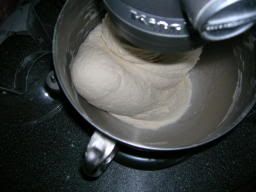
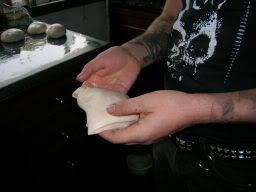
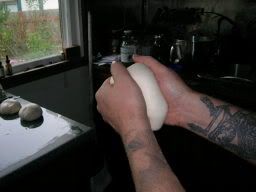
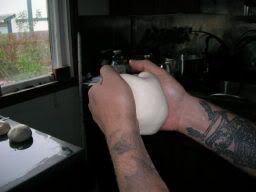

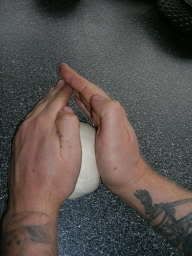
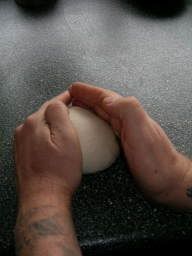
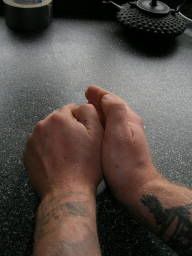
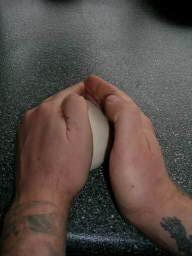
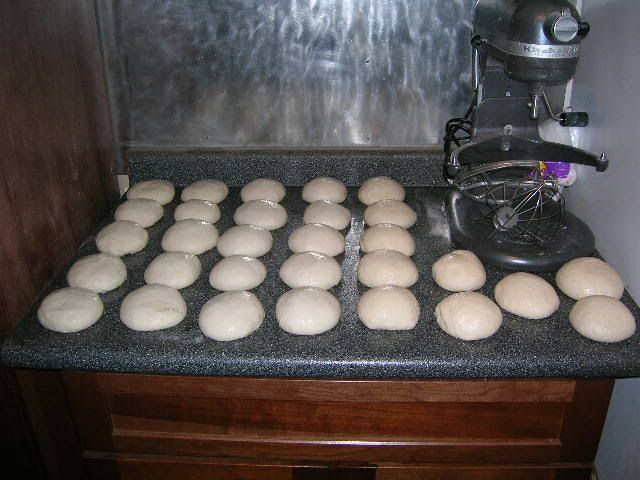
Comment